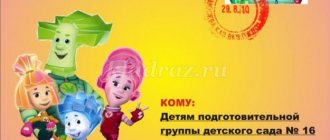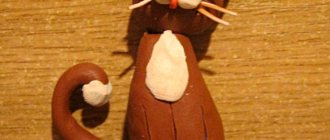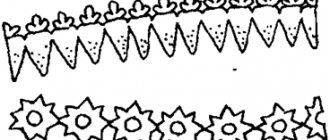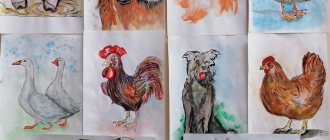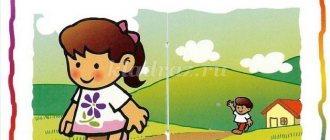Summary of GCD for modeling junior group Insects
Summary of educational activities
Cognition + sculpting
in the younger group
on the topic: “Insects in the clearing.”
Subject
: “Insects in the clearing”
Tasks:
— developing:
Continue to develop children's interest in understanding the world around them (insects live only in the summer), imagination, thinking, speech, and auditory perception.
- raising:
cultivate a desire to engage.
— educational
: expand children's understanding of insects living around us: beetle, butterfly, ladybug, caterpillar. Learn to name the distinctive features of appearance: the caterpillar has a long body and cannot fly; the beetle has antennae; The butterfly has beautiful wings. Continue to teach children the ability to assemble pictures from several parts.
Methods and techniques:
gaming – creating a gaming situation; verbal - conversation, question - answer, literary word; practical - performing actions with objects, demonstrating modeling techniques, performing a type of movement - walking on tiptoes.
Visual teaching aids:
Demo -
easel, illustrations of insects, illustrations of meadows (winter and summer), chairs.
Dispensing –
tray, pictures from 4 parts, insects according to the number of children, boards, plasticine.
GCD structure
: 1.hour introductory – 5 min; 2.h. main – 12 min; 3. final – 3 min.
Progress:
Children enter the group, I teach the children:
Me: “Guys, I suggest you take a walk to the clearing. In order not to scare off the insects, let's approach them on our tiptoes. Let’s say the sound “tssssss” to each other (we close our mouths with a finger to our lips, we turn our heads towards each other). Walking on tiptoe with the children, I pronounce the words:
In a forest clearing
In a clearing in the forest, a beetle and a caterpillar met. A butterfly also flew to them. It was a sunny day. And all three of us were friends
You appear in the clearing
And show yourself to the guys.
We go to the easels on which insects are displayed (beetle, butterfly, caterpillar, lady's box).
-Who is this, guys?
Children list insects.
- Guys, what does the beetle have? (paws, antennae...). Well done, right.
- The butterfly has (wings, antennae...). Fine. The caterpillar has (head...). Tell me which insect cannot fly (caterpillar). How does she move? (crawls). Guys, tell me what shape is God's head (round)? Colors? (black). Torso? (red)
I suggest going to the tables on which parts of the pictures lie.
Did. A game
“
Assemble a picture.” (
from 4 parts, assemble a whole one - a beetle, a caterpillar, a ladybug, a butterfly). Children list what they have collected.
Then I suggest you go to the carpet; on the carpet there is a large sheet of paper with a winter and summer landscape drawn on it.
Did. Game “What time of year do insects live?”
— At what time of year do insects appear? (In spring, when it gets warmer and green grass appears). That's right, well done. Here are the insects, I propose to take one insect at a time and put it in the clearing that depicts the time of year in which the insects live. Think and decide.
Children each take an insect and place it on the summer landscape.
- Tell me why you put it in the summer meadow? Children's answers:
- Because in winter they will freeze. It's cold in winter, warm in summer, etc. In winter, insects hide in the bark of trees to wait out the winter.
- That's right, insect guys can only live in the summer, and in the winter they will freeze from the cold.
Please note that we assembled a picture from 4 parts and among them there was a ladybug, but it is not in the clearing. Maybe he hasn’t woken up from the warm spring sun yet. A buzzing sound is heard. (I turn on the buzzing sound).
- So the beetle is looking for its girlfriend. I propose to help the beetle and make a ladybug so that he can have many friends.
Children go to their desks. There are boards and pieces of red and black plasticine on the tables. I show sculpting techniques and talk through my actions.
The children get to work. I help those who are in difficulty. At the end, the children also take their work to the green meadow.
“I’ll put my ladybug in a green clearing, there’s a beetle that’s been waiting for it for a long time.” (I take the ladybug to the table where the clearing is depicted). (from what colors of plasticine did we sculpt the ladybug, what shape is the head, body, what does the ladybug have on its back?
I analyze the lesson:
-Where did we go? Who were you considering? What time do insects live? etc.
https://nsportal.ru/detskiy-sad/applikatsiya-lepka/2016/11/06/konspekt-obrazovatelnoy-deyatelnosti-poznanie-lepka-vo
Summary of a modeling lesson in the second junior group. Topic: “How we sculpted a funny caterpillar”
Summary of a modeling lesson in the second junior group.
Topic: “How we sculpted a funny caterpillar”
Target:
- developing children's interest in modeling; familiarization with the properties of plasticine; nurturing such qualities as love of living nature, diligence and perseverance;
Tasks:
1. Teach children to work with plasticine: make three-dimensional and flat figures, using various techniques and methods;
2. Continue to develop fine motor skills of the hands;
3. Develop observation skills based on observation of the teacher’s work;
4. Continue to develop skills in working with plasticine;
5. Cultivate accuracy;
Preliminary work:
Looking at illustrations depicting caterpillars and butterflies.
Materials:
Multi-colored plasticine, a board, a cardboard sheet, a toy caterpillar.
Progress of the lesson:
Teacher: Hello guys!
Children say hello.
Teacher: - Now I will tell you one incident that happened to me in the summer... And you all know that Summer is a warm time of year, when everything blooms and rejoices. And I was happy in the summer.
I was walking along a path in a small forest. And I feel... something fell on my shoulder. Something small, even small and ticklish. At first I wanted to be scared, I almost screamed! But I changed my mind... And I decided to see what kind of guest came to me? I turned my head and... smiled. It was just a little caterpillar!
This is what she was like (showing a picture and a caterpillar toy). I looked at her, and she looked at me and smiled back at me. She took it off her shoulder and carefully placed it on the leaf. Caterpillars must live on the leaves, that’s where their home is. My dear caterpillar turned out to be very polite, she thanked me and said that now she would show me a small MIRACLE - a magical transformation.
- Which? – I asked.
- You will see the birth of a butterfly.
-Cribley! Crabs! Booms!!!! – the caterpillar whispered and then a wonderful butterfly appeared...
- That's what she was like, guys! - (show picture).
- Is it really beautiful?
Children: Yes!
“I saved a caterpillar and a magical butterfly was born!” And if I hadn’t planted it on a leaf, it could have fallen off my shoulder and broken. And that would be sad. We need to help all the little and helpless. You agree with me? Children's answer.
- Guys, have you seen butterflies? Children's answer. - And now you and I are making one, not an ordinary caterpillar! Our caterpillar will not be small, otherwise we will not see it. We're making a big one. And our caterpillar will be bright and cheerful. But first, we’ll warm up.
(Children get up. A physical minute is held)
- Come with us (Raise hands to the sides)
Let's stomp our feet, (Stomp our feet while standing still)
Let's clap our hands, (Clap our hands)
Today is a good day! (Raise straight arms up to the sides)
(completing of the work)
Teacher: Ready to sculpt. Children: Yes!
(plasticine of a color of the children’s choice is distributed) Teacher: - Take the prepared piece of plasticine and begin to warm it in your hands, transferring it from palm to palm. When it warms up, we will roll it between our palms. Show what you got. Well done. You should now have a sausage. Let's roll it between our palms some more so that it stretches out more.
The teacher shows how to skate and helps those who cannot cope.
Dynamic pause (stand in a circle):
In the morning the butterfly woke up, stretched and smiled. Once - she washed her face with her hand, Two - she spun gracefully, Three - she bent down and sat down, Four - she flew away.
Teacher: - Guys, now let's go back to our funny caterpillar. We rolled the sausage, and now we have to wrap it, and we will get a circle! The teacher shows how to roll a sausage and helps those who can’t do it.
The teacher takes white cardboard, sculpts a caterpillar head from plasticine and glues it onto the cardboard. Children bring their work, and the teacher glues the resulting circles as an extension of the body and signs each circle.
Teacher: Butterfly says thank you very much to all of you. She will now have a girlfriend, who will then turn into a butterfly!
Reflection:
Who came to visit us? Who did we sculpt today? Plasticine, what colors did we use?
Get text
Summary of a lesson with children of the second junior group on modeling “Vitamins for animals”
Modeling lesson for children of the second junior group “Vitamins for animals”
Description:
This material will be useful and interesting to teachers of younger groups and parents.
The lesson requires preliminary preparation. Goals:
- developing children's interest in modeling;
— familiarization with the properties of plasticine; - introduction to a new toy; — consolidating children’s knowledge about vitamins and their benefits. Objectives:
- continue to develop skills in working with plasticine;
- continue to develop knowledge about primary colors; - promote the development of aesthetic perception; - develop the ability to listen carefully to the teacher; - develop gross and fine motor skills; - strengthen children’s ability to tear small pieces from a large lump, roll balls and flatten them; - cultivate accuracy in work; — cultivate sympathy for someone else’s misfortune and a desire to help. Preliminary work:
reading K. Chukovsky “Doctor Aibolit”, a printed board game “Vegetables and Fruits”, looking at illustrations for the work of K. Chukovsky “Doctor Aibolit”, talking with children about a healthy lifestyle.
Equipment:
plasticine, board, napkins, paper blanks for a doctor’s suitcase, soft toy fox, printed board game “Vegetables and Fruits.
Assemble the puzzle”, a treat for children - apples. Progress of the lesson:
Children sit on chairs.
A knock is heard on the door. The teacher opens the door, and there is a fox. Chanterelle:
Guys, Doctor Aibolit sent me to you!
We're in trouble! Aibolit has run out of vitamins. Children:
What are vitamins for?
Educator:
Vitamins help children and adults to be strong and healthy.
Some vitamins are needed for growth, others - for the eyes - to see well, others - for the head - to think well, to be smart. And there are vitamins that protect us from diseases. If a child does not receive enough of these vitamins, he begins to get sick often. What do you think, at what time of year do we get the most vitamins? Children:
In summer and autumn, because there are a lot of fruits and vegetables at this time.
Chanterelle:
Well done guys!
You know a lot. And I know the game. Do you want to play? Children:
Yes.
The fox and the guys are playing the game “Put the puzzle together.” They collect various vegetables and fruits, and the teacher helps. Educator:
Guys, do you know that at other times of the year, so that people do not lack vitamins, vitamin tablets are sold in pharmacies.
And Doctor Aibolit ran out of such vitamins. Well guys, let's help Aibolit? Children:
Of course, we will help!
Educator:
Let's make some vitamins and put them in these suitcases.
And the fox will give it to Aibolit. The suitcase has compartments for vitamins, they are of different colors. What color vitamins will we make? Children name the colors drawn on the blank. The teacher shows the procedure. Children look carefully and show movements in the air. Educator:
We pinch off a small one from a large lump of plasticine, roll it into a ball in a circular motion and flatten it.
It turned out to be a vitamin. This is how I do the rest of my vitamins. (pronunciation and execution) Children look at the prepared material in front of them and begin to work at the prompting of the teacher. The teacher helps the children. In the middle of the lesson, the teacher conducts gymnastics for the eyes: We close our eyes tightly, count together to five, open them, blink and continue to work. Educator:
Our eyes rested a little.
Let's finish the job. Children finish modeling. The teacher and the fox conduct physical exercise. Our hands can clap - clap, clap. Our hands can slap - slap, slap. You can raise your arms up, you can shake them, knock with your fists, wave your wings, you can put your hands on your belt and make them dance with lanterns. You can shake hands with everyone and gather a big circle. Educator:
Well, guys, let's play.
Let's look at our vitamin cases. (look at the suitcases and discuss the work done) Educator:
we will show our suitcases with vitamins to our parents, and then send them by mail to Doctor Aibolit.
We exhibit our works at the stand. Chanterelle:
Guys, I really liked your place, can I stay?
Children:
Yes! The fox treats everyone with apples.
